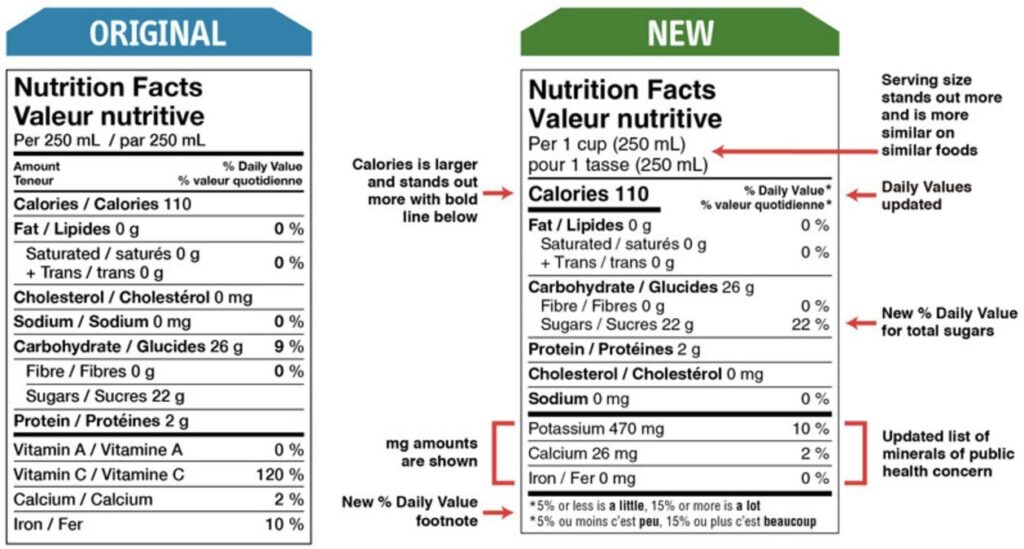The Canadian Food Inspection Agency and Health Canada recently announced changes to the way our food will be labeled in the near future. But what does it all mean? Read on for details about Canada's new food labeling regulations.
With health and wellness on everyone’s minds these days, the Canadian Food Inspection Agency (CFIA) and Health Canada are revamping their food labeling laws. From new symbols on your favourite snacks to clearer info on what’s really in your food, these changes are designed to make shopping healthier and easier than ever. With changes set to take effect by 2024-2025, here’s what you need to know to stay informed and make healthier choices when it comes to your food.

What’s New in CFIA Food Labeling: Key Updates and Deadlines
Front-of-Package (FOP) Symbols
Starting in 2024, look out for a new FOP symbol on food packages. It is a black-and-white magnifying glass that flags high levels of saturated fat, sodium and sugar. As delicious as pastries and frozen pizza are, it’s important to know whether they have too much of the wrong nutrients. The FOP symbol will make it easy for people to spot this and hopefully make healthier choices. Food labeling businesses must be compliant with this regulation by July 2026.

Updated Serving Sizes
Have you ever wondered who eats just half a cookie? The CFIA has tweaked serving sizes and the Table of Reference Amounts Customarily Consumed (RACC) to better reflect real-life eating habits, so what you see on a nutrition label is more aligned with what you realistically eat.
Daily Value Percentages, Made Simple
Labels now include the percentage of Daily Values (% DV) based on a standard 2,000-calorie diet. This shows you how much of each nutrient is in the food product, and how much that nutrient provides in the context of your overall daily intake.
Rounding Done Right
Nutritional info like weight and amount are also required to be rounded on food labels for a more accurate picture. Now, if you want to compare the nutritional value of your two favourite cereals, it is that much easier to do so.
Sugar and Sweetener Labeling
The new regulations state that there must be a clear distinction between “naturally occurring” and “added sugars;” also, all sweeteners must be explicitly listed by name. Too much sugar isn’t great for anyone, but especially for those with diabetes, obesity or high blood pressure. Compliance with this regulation is also required by January 2026.
Why These Changes Matter For Your Family
These updates are part of the CFIA's effort to make nutritional information more straightforward, so that you as a consumer can make informed and quick decisions when it comes to your diet. For businesses, staying ahead of these regulations means avoiding penalties and building trust with their customers through clearer labeling.
How Canada's New Food Labeling Regulations Help Parents
For parents, these new labeling regulations do more than just list certain ingredients; they make it easier to spot the good stuff and the not-so-good stuff in foods. This means you can quickly see what's in your kids' snacks and meals. It’s all about making healthier choices simpler for busy parents and carers. Brands that keep up with these changes show a commitment to transparency and help families make informed dietary choices, ultimately leading the charge in a more health-aware market.
How This Article Comes in Handy
- For Quick Reference: Keep this cheat sheet handy for an overview of upcoming changes and deadlines.
- For Detailed Planning: Use this guide to check your current food labels against upcoming requirements.
Additional Resources
For more in-depth guidance, consider visiting the following:
- The Canadian Food Inspection Agency (CFIA) and Health Canada websites for regulatory updates.
- The Canadian Institute of Food Safety (CIFS) for food safety training resources.
- The Food, Health and Consumer Products of Canada (FCPC) for compliance guidance.
- Food Label Maker’s Regulatory Hub for tools and insights on label adjustments.










